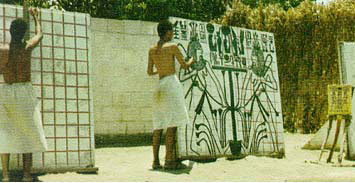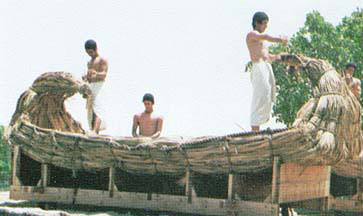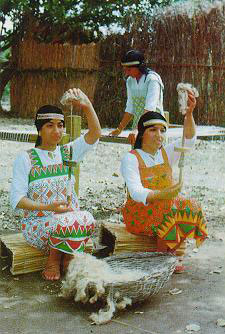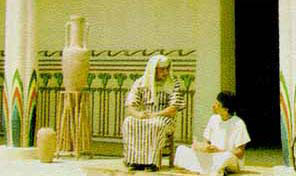Reconstruction of Ancient Glory
It is a village built entirely in the ancient style, inhabited by some 300 living in the Ancient Egyptian atmosphere and practicing all agricultural and industrial activities with the same tools and implements used in Ancient Egypt.The village covers 150,000 m2 at Ya'aqoob Island, Giza, only a few miles from downtown Cairo. The village teems with hundreds of birds and animals known in ancient times, some of which are now completely extinct. It is surrounded by 5000 trees tall enough to screen adjacent vestiges of modern life, making a visitor feel as if gone back 5000 years in history. Transportation through the village is carried out through navigable canals by means of floating amphitheatres. The idea of this village occurred to Dr. Hassan Ragab 20 years ago when he first came to Ya'aqoob Island to grow papyrus necessary for paper fabrication, an art which he brought back to life after it had disappeared for l000 years. The floating amphitheatre is called Dr. Ragab's Time Machine. It will go first through the canal of Mythology or Egyptian Pantheon.
PANTHEON AMON
Appearing, in the neighborhood of Thebes at the beginning of the Middle kingdom, Amon was represented as a human being sometimes with a ram's head. Mut, the Goddess near Karnak and Khons, the Moon God are his wife and son. Politics gave Amon historical success, for he was the God of the Theban Kings who drove out the Hyksos.
THOTH
Thoth, the lunar god in the form of a man with the head of ibis bird, holds the pen and scribe's inkpalette. Thoth is alluded to as the counter of the stars, the measurer and enumerator of earth, possessing knowledge of divine speech, the inventor of hieroglyphic writing from which sprang arts of reading and writing, lord of wisdom and magic. Thoth was worshipped in many places, but Hermopolis (Ashmounein) was the center of his cult. As to the sacred ibis bird, it has a white body with black head and tail and was common in the past, but no longer inhabits this country.
OSIRIS
Osiris is represented as a bearded man, mummiform, wearing crown, his hands project from wrappings, holding the crook and whip scepters. His flesh is often coloured in green, black. The original centre of cult was Busiris in Delta,then Abydos in Upper Egypt. Osiris was a very popular king and beloved of his followers,that made brother Seth jealous of him. The legend of Osiris told of his murder by Seth who tore Osiris 's body into 14 pieces and scattered them throughout Egypt. Isis, the faithful wife of Osiris, fetched for the pieces of his body and worked the greatest of her spells and revived him for one night of love when she conceived her child Horus. Then the body of Osiris was truly dead but his spirit lived on and Osiris became the king of the dead, and ruler of eternity.
ISIS
Isis was the sister and wife of Osiris. After the departure of her husband to the other world, Isis brought up her son Horus in the sheltered marshes of the Delta covered with papyrus. Isis was more popular than any other goddess. She typified the wife, faithful even after her husband's death, and the devoted mother. Her magic power, particularly in the care of children, would alone have increased the number of those who turned to her. She came from the Delta, but under Ptolemies & Romans, worship of Isis spread far beyond frontiers.
HORUS
Falcon-gods were numerous in Egypt, but the most famous is still Horus. For sometime, he remained god of aerial space, with the sun and moon as his two eyes. Sometimes, he himself become the sun under the name Rehorakhty.
In an open contest with Seth to recover his inheritance and following litigation before gods, Horus of Edfu won the day. It was believed that the eternal struggle between Horus and his uncle Seth was necessary for maintaining the balance of forces in the universe.
KHNUM
Khnum is represented in the form of a man with a ram's head and double horizontal horns. The god-giver of life who created the first man out of clay on his potter's wheel, acquired as his worship spread, a secondary function as guardian of Nile sources at Elephantine in Aswan.
HAPY
Hapy, god of the Nile, was represented as stout bearded man for power, with female breasts as sign of fertility and pendulous stomach as sign of opulence & nourishment. As god of the Nile he is crowned aquatic plants and holds a tray of foodproduce. He is green or blue, naked and long-haired, wearing girdle on loins like fisherman in marshes.
From the earliest period it was believed that the source of the Nile was from a cave between the cataracts of Aswan. There it sprang from two distinct sources in the nertherworld and divided into two rivers, one flowed northward through Egypt, the other took a southerly course through Nubia. These two sources of the Nile are represented by the two jars on the tray held between his hands. On the occasion of the annual rise of the Nile great festivals were held in honour of Hapy.
In front of the statue is seen a Nilometer, a gauge for measuring the height of the water at the peak of the annual Nile flood.
PTAH
Ptah was the God of the city of Memphis. He was represented in human form, tightly wrapped in a robe like a mummy. The political fortunes of Memphis made him one of the patrons of royalty and the presiding god at festivals. One ancient tradition attributed to him was the invention of crafts. Artisans came under his protection.
SEKHMET
It means "The powerful". Her centre of worship was Memphis and she was the consort of Ptah. She was believed to be a manifestation of the Eye of Ra' in rage and a destroyer of the enemies of the Sun God Ra'. The bloodthirsty Goddess was considered responsible for epidemics and disasters, and as she knew how to kill also knew how to heal. She formed one of the oldest associations of doctors and surgeons.
IMHOTEP
The name means "come in peace" and was given to him because he was supposed to bring the art of healing to mankind. He is depicted as seated man wearing skull cap. Before him is stretched papyrus roll on his knees to typify character as god of medicine. He was most popular in Egypt and famed as writer, physician. He contributed to founding disciplines of astronomy and architecture.
BES
Bes came to Egypt in the Twelfth Dynasty from the south, a dwarf with long arms, short bandy legs and tail. His wide, snub-nosed face bore shaggy beard and his huge eyes were half obscured by thick eyebrows. He had protruding tongue, crown of tall pumes. This god was a great favourite, and countless pendants and amulets were made in his likeness.His function was to protect people against evil influences, reptiles and malevolent beings. he protected women in childbirth.
THE GARDEN Bee-Keeping
God Ra’ wept and the tears from his eyes fell on the ground and turned into a bee which made his honeycomb and so wax was made and also honey out of the tears of god Ra'...Honey played a large part in the diet of Ancient Egyptians.
Next, one sees a Pharaonic garden with a pond containing lotus and other aquatic flowers prevalent in Ancient Egypt. Surrounding the pond we see samples of some of the typical Egyptian trees amongst which we cite sycamore fig, olive, acacia, doum, date palm, sidr ( jujube ), pomegranate, henna, castor oil, Assyrian plum, tamarisk, and vine. Growing of wheat, for example, has the following observed steps: ploughing, furrowing, sowing, irrigation, harvesting, threshing, winnowing and storing.
CRAFTS
The Ancient Egyptians knew boat construction, fishing, brick-making, brick construction, pottery- making, painting, carving on walls and carpentary. They also had a very well-equipped arms arsenal. They excelled in perfume-making, in linen spinning and weaving and not to forget wine-making.
Papyrus
Papyrus paper was invented and used in Egypt as a writing material nearly 3000 years before the Chinese T'sai lunn invented paper in China. Egypt had a monopoly on papyrus manufacture and remained the sole supplier of papyrus throughout the ancient world.
THE TEMPLE
It has got the Ram-headed Sphinx Avenue - Pylon which consists of two massive symmetrical towers. The Open Court that is surrounded by a porch supported by a row of columns Hypostyle Hall where the brilliant sunlight of the outside world is dimmed. Sanctuary which contains the sacred portable barque on which the god's idol is placed Mummification Room The Priests' Quarters. The Sacred Lake where at dawn the priests purified themselves in the waters before beginning their services.
TREES
On the way to visit the Nobleman's Villa, there is a collection of trees prevalent in Ancient Egypt, such as: doum palm, acacia, pomegranate, Assyrian plum, Sycamore Fig, olive, henna, jujube, tamarisk, date palm, common figs, white mulberry and weeping willow vine.
NOBLES VILLA
There is a fore-garden, square pool sprinkled with coloured water lillies, some arched pergolas, climbing vines, staircase leading to the roof, verandah supported by four columns, pillared hall, main drawing room, living room, dining room, then all sorts of facilities as in a modern household.
PEASANT HOUSE
It is very simple; consisting of one room and front and back yards.





